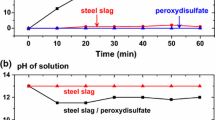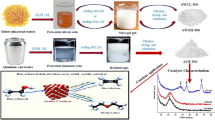Abstract
The steelmaking slag (SMS) is a by-product of steelmaking factories and a valuable industrial waste, which is a heterogeneous mixture of some common metal oxides such as SiO2, Al2O3, Fe2O3, CaO, and MgO. The SMS is a readily available, non-toxic, environmentally friendly, thermally stable, and reusable magnetic heterogeneous catalyst that can be easily handled and it showed a good magneto-catalytic performance. In this work, a successful and versatile water preparation of 5-substituted-1H-tetrazoles in the presence of steelmaking slag as a catalyst is reported via click reaction. A series of aliphatic and aromatic nitriles underwent via [3 + 2] cycloaddition reaction with sodium azide under standard conditions to afford a diverse array of 5-substituted-1H-tetrazoles in good to excellent yields. The reactions occur at almost low reaction times, with no need of inert reaction conditions and avoids usage or formation of any potentially toxic or explosive chemicals. The SMS catalyst was characterized by FT-IR spectroscopy, powder X-ray diffraction, energy‐dispersive X‐ray mapping and scanning electron microscopy, and X-ray fluorescence techniques. Moreover, the procedure is simple, cost effective, and reliable that holds potential for further applications in organic syntheses and industrial requirements.
Graphical Abstract








Similar content being viewed by others
References
Kuwahara Y, Ohmichi T, Kamegawa T et al (2010) A novel conversion process for waste slag: synthesis of a hydrotalcite-like compound and zeolite from blast furnace slag and evaluation of adsorption capacities. J Mater Chem 20:5052–5062
Borja Á, Tueros I, Belzunce MJ et al (2008) Investigative monitoring within the European Water Framework Directive: a coastal blast furnace slag disposal, as an example. J Environ Monit 10:453–462
Mudhoo A, Sharma SK (2011) Microwave irradiation technology in waste sludge and wastewater treatment research. Crit Rev Environ Sci Technol 41:999–1066
Yi H, Xu G, Cheng H et al (2012) An overview of utilization of steel slag. Procedia Environ Sci 16:791–801
Liu H, Lu H, Chen D et al (2009) Preparation and properties of glass–ceramics derived from blast-furnace slag by a ceramic-sintering process. Ceram Int 35:3181–3184
Kuwahara Y, Tsuji K, Ohmichi T et al (2012) Transesterifications using a hydrocalumite synthesized from waste slag: an economical and ecological route for biofuel production. Catal Sci Technol 2:1842–1851
Shen H, Forssberg E (2003) An overview of recovery of metals from slags. Waste Manag 23:933–949
Luo S, Zhou Y, Yi C (2012) Hydrogen-rich gas production from biomass catalytic gasification using hot blast furnace slag as heat carrier and catalyst in moving-bed reactor. Int J Hydrog Energy 37:15081–15085
Pradeep A (2015) Effect of blast furnace slag on mechanical properties of glass fiber polymer composites. In: 2nd Int Conf Nanomater Technol (CNT 2014)
Liu J, Yu Q, Peng J et al (2015) Thermal energy recovery from high-temperature blast furnace slag particles. Int Commun Heat Mass Transf 69:23–28
Fisher LV, Barron AR (2019) The recycling and reuse of steelmaking slags—a review. Resour Conserv Recycl 146:244–255
Khater G (2011) Influence of Cr2O3, LiF, CaF2 and TiO2 nucleants on the crystallization behavior and microstructure of glass-ceramics based on blast-furnace slag. Ceram Int 37:2193–2199
Walling SA, Bernal SA, Gardner LJ et al (2018) Blast furnace slag-Mg(OH)2 cements activated by sodium carbonate. RSC Adv 8:23101–23118
Du J, Bu Y, Guo S et al (2017) Effects of epoxy resin on ground-granulated blast furnace slag stabilized marine sediments. RSC Adv 7:36460–36472
Kostura B, Kulveitova H, Leško J (2005) Blast furnace slags as sorbents of phosphate from water solutions. Water Res 39:1795–1802
Johansson L, Gustafsson JP (2000) Phosphate removal using blast furnace slags and opoka-mechanisms. Water Res 34:259–265
Maghchiche A, Naseri R, Haouam A (2012) Uses of blast furnace slag as complex fertilizer. J Chem Chem Eng 6:853–859
Doble M, Kruthiventi AK (2007) Green chemistry and processes. Academic, New York
Clark JH (2002) Solid acids for green chemistry. Acc Chem Res 35:791–797
Anastas PT, Warner JC (1998) Principles of green chemistry. Green Chem 29–56
Anastas PT, Beach ES (2007) Green chemistry: the emergence of a transformative framework. Green Chem Lett Rev 1:9–24
Varma R (1999) Solvent-free organic syntheses. using supported reagents and microwave irradiation. Green Chem 1:43–55
Tanaka K (2009) Solvent-free organic synthesis. Wiley, New York
Kerton FM, Marriott R (2013) Alternative solvents for green chemistry, vol 20. Royal Society of Chemisty, Sheffield
Zhao H, Xia S, Ma P (2005) Use of ionic liquids as ‘green’solvents for extractions. J Chem Technol Biotechnol 80:1089–1096
Horváth IT (2011) Fluorous chemistry. Springer, New York
Horváth IT (1998) Fluorous biphase chemistry. Acc Chem Res 31:641–650
Gawande MB, Bonifácio VD, Luque R et al (2013) Benign by design: catalyst-free in-water, on-water green chemical methodologies in organic synthesis. Chem Soc Rev 42:5522–5551
Reichardt C, Welton T (2011) Solvents and solvent effects in organic chemistry. Wiley, New York
Sarvary A, Maleki A (2015) A review of syntheses of 1, 5-disubstituted tetrazole derivatives. Mol Divers 19:189–212
Mittal R, Awasthi SK (2019) Recent advances in the synthesis of 5-substituted 1H-tetrazoles: a complete survey (2013–2018). Synthesis 51:3765–3783
Wei C-X, Bian M, Gong G-H (2015) Tetrazolium compounds: synthesis and applications in medicine. Molecules 20:5528–5553
Abdollahi-Alibeik M, Moaddeli A (2016) Cu-MCM-41 nanoparticles: an efficient catalyst for the synthesis of 5-substituted 1H-tetrazoles via [3+2] cycloaddition reaction of nitriles and sodium azide. J Chem Sci 128:93–99
Herr RJ (2002) 5-Substituted-1H-tetrazoles as carboxylic acid isosteres: medicinal chemistry and synthetic methods. Bioorg Med Chem 10:3379–3393
Voitekhovich SV, Lesnyak V, Gaponik N et al (2015) Tetrazoles: unique capping ligands and precursors for nanostructured materials. Small 11:5728–5739
Frija LMT, Ismael A, Cristiano MLS (2010) Photochemical transformations of tetrazole derivatives: applications in organic synthesis. Molecules 15:3757–3774
Kumar A, Kumar S, Khajuria Y et al (2016) A comparative study between heterogeneous stannous chloride loaded silica nanoparticles and a homogeneous stannous chloride catalyst in the synthesis of 5-substituted 1H-tetrazole. RSC Adv 6:75227–75233
Frija L, Cristiano MLS, Gómez-Zavaglia A et al (2014) Genesis of rare molecules using light-induced reactions of matrix-isolated tetrazoles. J Photochem Photobiol C 18:71–90
Yu H-L, Zhang F, Lan T et al (2014) Effects of 6-(4-chlorophenoxy)-tetrazolo [5, 1-a] phthalazine on anticoagulation in mice and the inhibition of experimental thrombosis in rats. J Cardiovasc Pharmacol 64:560–566
Bladin J (1885) Ueber von dicyanphenylhydrazin abgeleitete verbindungen. Ber Dtsch Chem Ges 18:1544–1551
Demko ZP, Sharpless KB (2001) Preparation of 5-substituted 1H-tetrazoles from nitriles in water. J Org Chem 66:7945–7950
Azadi G, Ghorbani-Choghamarani A, Shiri L (2017) Copper (II) immobilized on Fe3O4@SiO2@l-Histidine: a reusable nanocatalyst and its application in the synthesis of 5-substituted 1H-tetrazoles. Transit Met Chem 42:131–136
Nanjundaswamy HM, Abrahamse H (2014) Green synthesis of 5-substituted-1H-1, 2, 3, 4-tetrazoles and 1-sustituted-1H-1, 2, 3, 4-tetrazoles via [3+2] cycloaddition by reusable immobilezed AlCl3 on γ-Al2O3. Heterocycles 89:2137–2150
Roh J, Vávrová K, Hrabálek A (2012) Synthesis and functionalization of 5-substituted tetrazoles. Eur J Org Chem 2012:6101–6118
Maleki A, Sarvary A (2015) Synthesis of tetrazoles via isocyanide-based reactions. RSC Adv 5:60938–60955
Ghodsinia SS, Akhlaghinia B (2015) A rapid metal free synthesis of 5-substituted-1H-tetrazoles using cuttlebone as a natural high effective and low cost heterogeneous catalyst. RSC Adv 5:49849–49860
Kumar S, Kumar A, Agarwal A et al (2015) Synthetic application of gold nanoparticles and auric chloride for the synthesis of 5-substituted 1H-tetrazoles. RSC Adv 5:21651–21658
Matlack A (2010) Introduction to green chemistry. CRC Press, Boca Raton
Lakshmi Kantam M, Kumar KS, Sridhar C (2005) Nanocrystalline ZnO as an efficient heterogeneous catalyst for the synthesis of 5-substituted 1H-tetrazoles. Adv Synth Catal 347:1212–1214
Mitra B, Mukherjee S, Pariyar GC et al (2018) One pot three-component synthesis of 5-substituted 1H-tetrazole from aldehyde. Tetrahedron Lett 59:1385–1389
Kobayashi E, Togo H (2018) Facile one-pot preparation of 5-aryltetrazoles and 3-arylisoxazoles from aryl bromides. Tetrahedron 74:4226–4235
Lamie PF, Philoppes JN, Azouz AA et al (2017) Novel tetrazole and cyanamide derivatives as inhibitors of cyclooxygenase-2 enzyme: design, synthesis, anti-inflammatory evaluation, ulcerogenic liability and docking study. J Enzym Inhib Med Chem 32:805–820
Yao X, Yu Q, Xu G et al (2018) The characteristics of syngas production from bio-oil dry reforming utilizing the waste heat of granulated blast furnace slag. Int J Hydrog Energy 43:22108–22115
Movaheditabar P, Javaherian M, Nobakht V (2017) CuO/aluminosilicate as an efficient heterogeneous nanocatalyst for the synthesis and sequential one-pot functionalization of 5-substituted-1H-tetrazoles. React Kinet Mech Catal 122:217–228
Movaheditabar P, Javaherian M (2019) Nano silica melamine trisulfonic acid as an efficient and reusable heterogeneous catalyst for the synthesis of 5-substituted-1H-tetrazoles. Org Chem Res 5:174–189
Movaheditabar P, Javaherian M, Nobakht V (2021) Igneous rock powder as a heterogeneous multi-oxide nano-catalyst for the synthesis of 5-substituted-1H-tetrazoles in polyethylene glycol. J Iran Chem Soc 10:1–12
Wang Z, Liu Z, Cheon SH (2015) Facile synthesis of 5-substituted 1H-tetrazoles catalyzed by tetrabutylammonium hydrogen sulfate in water. Bull Korean Chem Soc 36:198–202
Meshram GA, Deshpande SS, Wagh PA et al (2014) Silica supported lanthanum triflate mediated synthesis of 5-substituted-1H tetrazoles. Tetrahedron Lett 55:3557–3560
Salahshournia B, Hamadi H, Nobakht V (2018) Engineering a Cu-MOF nano-catalyst by using post-synthetic modification for the preparation of 5-substituted 1H-tetrazoles. Appl Organomet Chem 32:e4416
Akhlaghinia B, Rezazadeh S (2012) A novel approach for the synthesis of 5-substituted-1H-tetrazoles. J Braz Chem Soc 23:2197–2203
Acknowledgements
The authors wish to acknowledge the financial support received from the committee grant of the Department of Chemistry, Faculty of Science, Shahid Chamran University of Ahvaz, Ahvaz, Iran (Grant No. SCU.SC98.440).
Author information
Authors and Affiliations
Corresponding author
Ethics declarations
Conflict of interest
All authors have received research grants from Department of Chemistry, Faculty of Science, Shahid Chamran University of Ahvaz, Ahvaz, Iran. There are no conflicts of interest to declare.
Additional information
The contributing editor for this article was Veena Sahajwalla.
Publisher's Note
Springer Nature remains neutral with regard to jurisdictional claims in published maps and institutional affiliations.
Supplementary Information
Below is the link to the electronic supplementary material.
Rights and permissions
About this article
Cite this article
Movaheditabar, P., Javaherian, M. & Nobakht, V. Steelmaking Slag as a Valuable Industrial Waste in the Preparation of 5-Substituted-1H-Tetrazoles on Water. J. Sustain. Metall. 8, 882–892 (2022). https://doi.org/10.1007/s40831-022-00533-9
Received:
Accepted:
Published:
Issue Date:
DOI: https://doi.org/10.1007/s40831-022-00533-9




